Soldier Story: Wilbert Sanderson Holck
Soldier Story

Wilbert Sanderson Holck
Sergeant
442nd Regimental Combat Team
Cannon Company
Wilbert Sanderson Holck was born on October 12, 1925, in Honolulu, Territory of Hawaii. He was the eldest child of Fred Katsutaro and Mary Ann (Holck) Matsuno. His siblings were: Joseph, Frederick Albert, Yolanda Haunani, and Roy Arnold Vitousek Matsuno.
Wilbert’s mother Mary Ann Honuaiwakalani Holck was the granddaughter of Jacob Martinus Holck, a well-known wheelwright who immigrated from Bergen, Norway, in the mid-1800s. He married a Hawaiian woman, Mary Ann Pokea, and their only son, Oscar Holck, was the father of Mary Ann.
In 1920, father Fred Katsutaro Matsuno was age 13 and living on Queen Street with his parents Tsuneichi and Tsuru (Aoki) Matsuno and six siblings. Tsuneichi was a fisherman who emigrated with his wife Tsuru from Yamaguchi Prefecture, Japan, in 1897. All of the children were born in Hawaii.
By 1930, Fred Katsutaro Matsuno was age 23, married to Mary Ann Holck, and living at 1536-A Holt Lane with their three children. Katsutaro was a salesman in the household department of a retail store. Wilbert attended Washington Intermediate School, where in December 1938 he played the part of Joseph in the play, “The Coming of the Prince of Peace,” at the St. Andrew’s Cathedral Tenney Auditorium. In 1940 he attended the camp at Kokokahi in windward Oahu sponsored by the Board of Religious Education. He was president of the student council who helped plan the activities for the retreat. He graduated from Washington Intermediate School in May 1940.
By 1940, the family was living at 5420 Ohe Lane, there were four sons and one daughter, and Fred was the timekeeper for the City & County of Honolulu Building Department. Living with the family was 15-year-old nephew Kozuichi Hirakawa, an aku (skipjack tuna) fisherman.
Wilbert attended McKinley High School where he was on the junior football team. In May 1942, he was a member of the Catholic Youth Organization (CYO) boxing team.
On January 25, 1943, Fred Katsutaro Matsuno and Mary Ann Holck Matsuno had the names of their five children, all minors under the age of 21, changed as follows: Wilbert Sanderson Tsunekichi Matsuno became Wilbert Sanderson Holck; Joseph Matsuno became Joseph Holck; Yolanda Haunani Matsuno became Yolanda Haunani Holck; Frederick Albert Matsuno became Frederick Albert Holck; and Roy Arnold Vitousek Matsuno became Roy Arnold Vitousek Holck. The decree was signed by Acting Governor Ernest K. Kai and published in the Honolulu Star-Bulletin. The brothers later said that their surname had been changed in order to perpetuate the Holck name in Hawaii.
Sandy, as Wilbert had come to be known, signed his draft registration card a few days after this name change on February 2, 1943, Local Board No. 5, in Room 24, Royal School, Punchbowl Street in Honolulu. He was 5’6” tall and weighed 130 pounds. His father was his point of contact and the family lived at 526-D Koula Street. His father was an accountant for the City & County of Honolulu. Sandy was unemployed but awaiting a call from the U.S. Engineering Department (USED) for employment. He initially signed his surname as Matsuno, but that was blotted out and Holck signed over it.
He enlisted in the Army a month later on March 25, 1943. He was sent to the “tent city” nicknamed Boomtown at Schofield Barracks along with the other volunteers for the 442nd Regimental Combat Team. The soldiers were given an aloha farewell ceremony on the grounds of Iolani Palace on March 28, 1943.
The new soldiers then left Honolulu on April 4 on the S.S. Lurline for California. Upon arrival at Oakland, they were sent by train across the US to Camp Shelby, Mississippi.
Once they arrived at Camp Shelby, the men were assigned to their company prior to basic training, which began on May 10 and ended on August 23. The initial company to which Private Holck was assigned is not known. After basic training ended, there was a brief break so the new soldiers had time for short passes and furloughs. Holck was among a group of Hawaii soldiers who visited Washington DC and New York City during their time off. On one day in the nation’s capital, 30 men including Holck visited the office of Hawaii’s Delegate Joseph R. Farrington in the Old House Office Building.
When the men returned, training was set to restart with unit training according to each soldier’s unit within the Combat Team.
While the men were on their short furlough, however, the 442nd had decided to activate a Cannon Company at the regimental level, and this occurred on September 3. Six officers were chosen, and they selected 150 men – including Pvt. Sandy Holck – from other companies to transfer to the new Cannon Company.
Cannon Company consisted of six light, truck-drawn, 105mm howitzers. This gave the regimental commander his own artillery that he could use when the Combat Team’s 522nd Field Artillery Battalion was firing another mission or needed additional support. Cannon Company could also shoot under the direction of the 522nd’s Fire Direction Center as an extra firing battery. Cannon Company’s six howitzers were divided equally to support the three infantry battalions of the Combat Team.
After nearly a year of training and field maneuvers, the 442nd left Camp Shelby on April 22, 1944, by train for Camp Patrick Henry, Virginia. On May 2, they sailed from nearby Hampton Roads in a convoy of over 100 ships bound for the Theater of War.
After a lengthy crossing, the 442nd arrived at Naples, Italy, on May 28 to join in the Rome-Arno Campaign. The Combat Team spent the next two weeks at a bivouac at Staging Area No. 4 in nearby Bagnoli. While there, some of the men – including Sandy Holck – took advantage of the opportunity to visit the ruins of nearby Pompeii. The 442nd then left on LSTs and LCIs on June 6 and arrived at the recently liberated Anzio beachhead the next day. Finally, on June 9 they headed out in a convoy through the city of Rome, which had just been liberated on June 4, for a large bivouac near Civitavecchia, about 50 miles north. There they made final preparations to advance to the front lines.
While at Civitavecchia, Holck was able to visit Rome, where he later wrote to his father in a V-mail letter (as published in the July 16 issue of the Honolulu Advertiser):
Hi Ya Pop, Received a couple of letters from you a few days ago. Those letters were welcomed with open hands. Anything from home, you can imagine how glad I was. I visited the former Queen’s palace, and also the ruins of Pompeii. I also visited Rome. I didn’t see very much of Rome, since I did not have enough time. But I can say that Rome is a beautiful place. You’ll be surprised how modernized its buildings are……I visited St. Peter’s Cathedral in Vatican City, where Pope Pius XII lives. My Rosary was blessed by the Pope himself. How’s that eh, Pop? By the time I get back to Hawaii, I could say I’ve seen at least half the world. I did not see Akira Ishimoto yet [Note: Sergeant, G Company], since we have been awful busy. But I’ll try to see him. So until next time, write soon. Your son, Sandy
The 442nd entered combat on June 26, 1944, near Suvereto. They encountered some heavy fighting as they continuously pushed the Germans up the Italian peninsula. During this time, they saw their heaviest fighting at the battle for Hill 140 just north of the Cecina River.
In late September, the 442nd was sent to Naples for shipment to France, where they joined in the Rhineland-Vosges Campaign. They arrived at Marseilles on the coast of southern France on September 29 after a 2-day voyage, and bivouacked at nearby Septèmes prior to traveling over 500 miles north by truck or rail boxcars to the Vosges Mountains.
The weather in the Vosges was cold, wet, snowy, and miserable, as the men fought in the heavily wooded forests still in their summer uniforms. During the bitter fighting for their first mission – the liberation of the important road and rail junction of Bruyères – they were subjected to living in wet foxholes with incoming artillery raining down on them in “tree bursts.” They fought from October 14 to 18, finally taking the town house by house. When they succeeded, the citizens emerged from where they had been hiding in their cellars and were surprised to find their liberators were young, fresh-faced Japanese Americans – always smiling, always polite. The young men shared their rations, against orders, with the citizens and they came to be known as “gentlemen soldiers.”
Next came liberating the neighboring villages of Biffontaine and Belmont, and the “Rescue of the Lost Battalion” – the 1st Battalion, 141st (Texas) Infantry that had advanced beyond the lines and was surrounded on three sides by the enemy.
Finally, on November 17, the 442nd was relieved from the front lines after 25 days of heavy fighting, and sent to the south of France. There, they could rebuild to full combat strength while fighting in the Rhineland-Maritime Alps Campaign, which was mostly a defensive position guarding the French-Italian border from incursion by the German Army in Italy.
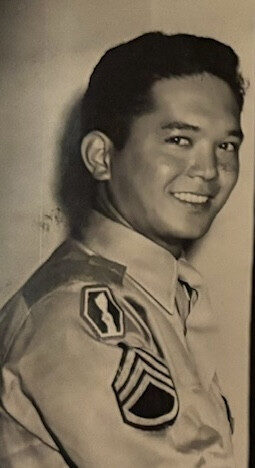
Right: Staff Sergeant Holck during the war
The 442nd was in the Maritime Alps Campaign beginning on November 23, 1944. While there, they often had short passes to spend time in Nice relaxing or sightseeing. For this reason, the men nicknamed this the “Champagne Campaign.”
On March 15, 1945, the Combat Team was relieved and moved in relays to the new staging area at Marseilles. On March 20-22, the 442nd (without its 522nd Field Artillery Battalion who were sent to Germany) left France to fight in the Po Valley Campaign for the final push to defeat the Nazis in Italy. They arrived at the Peninsular Base Section in Pisa on March 25 and were assigned to Fifth Army. The 442nd fought in the Po Valley Campaign in what was planned as a diversionary attack up the west coast while the main thrust of the Allies in Italy was farther east.
The 442nd relentlessly pursued the enemy in their diversionary attack, resulting in a complete breakthrough of the Gothic Line in the west. This broke the 5-month stalemate when other units were unable to get through the German’s defenses. The 442nd then pushed the enemy further north. Despite orders from Hitler to fight on, the German forces in Italy surrendered on May 2, 1945, a week before the rest of the German forces in Europe surrendered.
Holck served during the occupation when the 442nd was first in bivouac at Novi Ligure, then sent to Ghedi Airfield to process and guard German prisoners of war, followed by Lecco on Lake Garlate where they enjoyed Lake Como and the beautiful countryside. While in Lecco, in July the Combat Team held an award presentation and Sgt. Holck received a Bronze Star Medal from Colonel Virgil R. Miller, commander of the 442nd RCT, for “installing and maintaining difficult communication lines under enemy fire.”
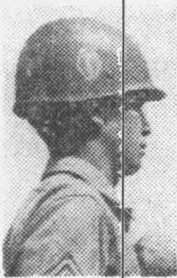
Left: Sgt. Holck receiving his Bronze Star Medal
Following their time in Lecco, the Combat Team moved to engage in more occupation duties in the Livorno-Pisa-Florence area.
In late 1945, Sgt. Holck was finally able to leave Italy. He arrived at Honolulu Harbor’s Pier 24 on December 5, 1945, on the S.S. Evangeline with 567 other war veterans. After disembarking, the men had an hour to be greeted by the large throng of family and friends gathered on the dock. They were then trucked to Fort Kamehameha and processed at the Army’s Separation Center before being released to return later for discharge.
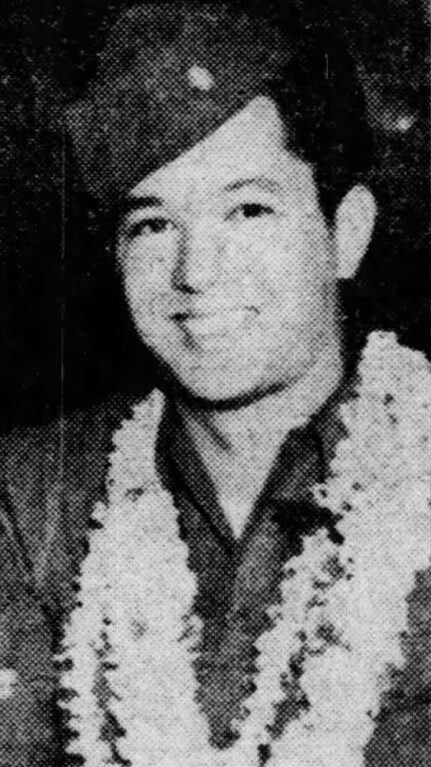
Right: Holck on arrival home, December 5, 1945
Holck was discharged from the U.S. Army on December 28, 1945.
For his military service in World War II, Sergeant Wilbert Sanderson Holck was awarded the: Bronze Star Medal with one oak leaf cluster, Purple Heart Medal, Good Conduct Medal, American Campaign Medal, European-African-Middle Eastern Campaign Medal with four bronze stars, World War II Victory Medal, Army of Occupation Medal, Distinguished Unit Badge with one oak leaf cluster, and Combat Infantryman Badge. He was awarded the Congressional Gold Medal on October 5, 2010, along with the other veterans of the 100th/442nd Regimental Combat Team. Conferred by the U.S. Congress, the award states: “The United States remains forever indebted to the bravery, valor, and dedication to country these men faced while fighting a two-fronted battle of discrimination at home and fascism abroad. Their commitment and sacrifice demonstrate a highly uncommon and commendable sense of patriotism and honor.”
Holck reenlisted on June 30, 1946, for three years. Upon his discharge on May 3, 1949, he reenlisted the next day, May 4. In 1950-1951, Holck served in the Korean War as an operations sergeant with the 24th Infantry Division. He served until he was discharged on October 16, 1952. Holck then reenlisted again and continued to serve.
On December 20, 1952, Sandy Holck married Chisato Maebo, originally from Hilo. She was the daughter of Mamoru and Shizuko Maebo.
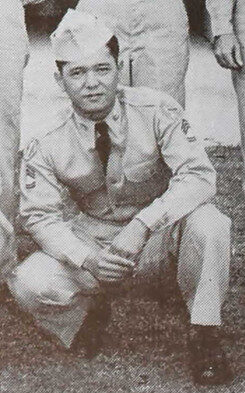
Left: Sergeant First Class Holck in the 1954 UH yearbook
By 1954, SFC Holck was serving at the University of Hawaii as an instructor in their Reserve Officers Training Corps (ROTC) program. He and his family lived at 472-A North Kainalu Drive in Kailua on the windward side of Oahu.
In the spring of 1960, Master Sergeant Holck was stationed in Bad Kreuznach, Germany, with the Headquarters Detachment, 8th Infantry Division. He, his wife, and two of their children visited Bruyères – as he later recalled – on a “pilgrimage of peace to places I had only seen through the sights of a rifle.” He wanted to “see places I had fought, the people who had helped us, and especially I wanted to find out if they still remembered the men from Hawaii.”
His reception in Bruyères exceeded his wildest expectations. Mayor René Drahon and the townspeople greeted him like a VIP. According to Holck, he “found out that the people of Bruyères hadn’t forgotten us and it sort of hit me in the heart.”
While in Bruyères, Mayor Drahon introduced the Holcks to local citizen Gérard Deschaseaux, a local elected official who spoke some English.
Below: Mayor Drahon (center) introduces the Holcks to Gérard Deschaseaux
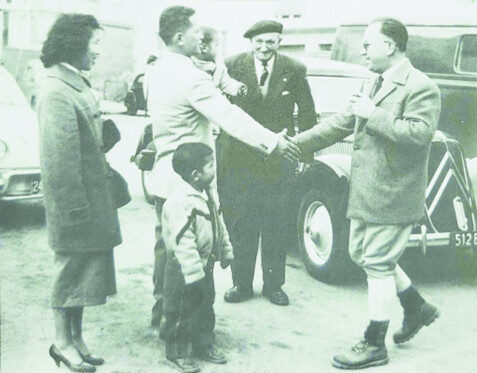
After Bruyères, Holck and his family visited the nearby village of Biffontaine, where he was hoping to find the friendly Russian-born farmer and his French wife who had sheltered him and his platoon during the mop-up operations after they liberated Biffontaine. Mayor Drahon knew exactly who this was and took the Holcks to the home of Alexandre Tarantseff. As Holck recalled:
There was a lot of hugging and shouting and tears. He recognized me right away. Even his son, who was eleven when we fought there, remembered me. We had a terrific reunion and I went back at Christmas time with my family (wife and six children). They gave us the most wonderful French dinner I ever had.
Below: Tarantseff family with Chisako and Sandy Holck and two of their children
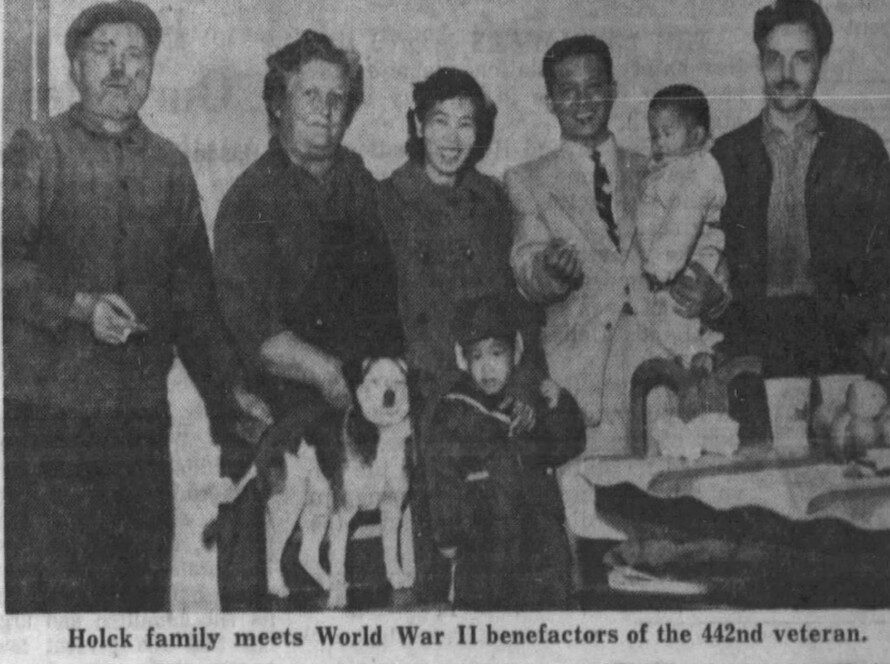
After his visit, Holck returned to Bruyères a few more times and became close friends with Gérard Deschaseaux. The two men decided that their two cities needed to formally recognize their close bonds. They were jointly successful in forming the Sister City relationship between Honolulu and Bruyères. The mission was to cement the relationship formed by the gratitude of the people of Bruyères to the men of the 442nd RCT for liberating their town in 1944. The formal agreement was signed by Mayor Neil S. Blaisdell of Honolulu and Mayor René Drahon of Bruyères on October 16, 1961. Over the succeeding years, Holck helped arrange and hosted many exchange visits by the citizens of Bruyères and the 442nd veterans. For the 50th anniversary he arranged the visit of about 700 veterans and their families to Bruyères.
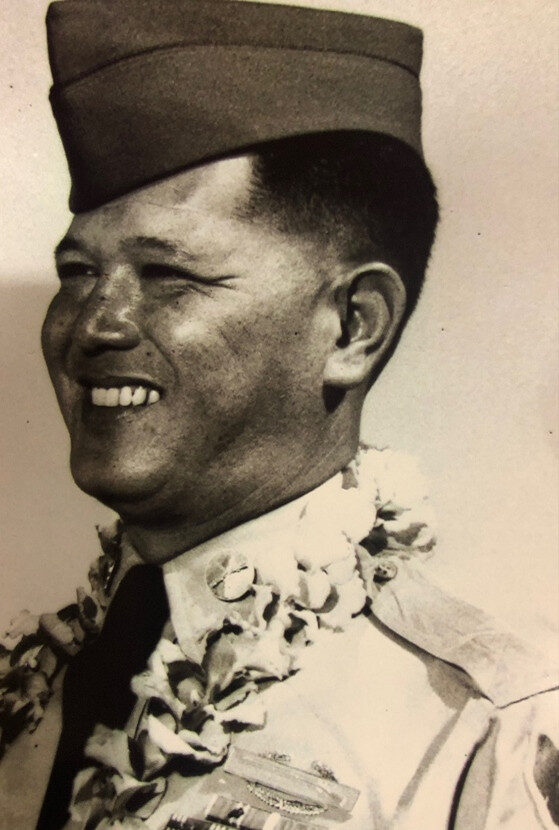
Right: MSgt Holck, 1963
Holck retired from the U.S. Army at Schofield Barracks as a Master Sergeant on December 31, 1963. He was then employed for eight years as Deputy Clerk for the City & County of Honolulu. Holck was elected to the Honolulu City Council in 1974, representing Windward Oahu until 1978. During his tenure, he was instrumental in controlling high-rise development in Kailua. His father Fred K. Matsuno died in Kailua on December 19, 1978, at the age of 72. Holck was appointed to various other government positions, and he eventually retired from government service in 1987.
He was also employed in the early 1980s by the Real Estate Commission in Honolulu. And, he worked as a tour leader in 1983-1986 for European World Travel Service, Inc. in Honolulu and also was President of Sandy’s Travel Adventures, Inc.
Below: Holck in later years
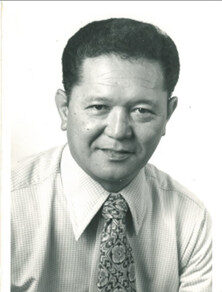
Holck moved to Tucson, Arizona, in the late 1980s. His brothers Roy and Joe had previously moved there in the early 1960s and operated a jujitsu school.
Wilbert Sanderson Holck died on March 5, 1999, at the age of 73 in Tucson. His memorial service was held on March 15 at Hawaiian Memorial Park, 45-425 Kamehameha Highway, Kaneohe, followed by burial in Section 148-H, Site 6 at the adjacent Hawaii State Veterans Cemetery. His survivors included his wife, five sons, four daughters, 11 grandchildren, brothers Joseph, Frederick, and Roy, and sister Mrs. Yolanda Silva. His tombstone is inscribed Beloved Sandy Cannon Company 442 Inf Regt Go For Broke.
Brother Frederick Albert Kaleikaumaka Holck served as a Colonel in the U.S. Army. Brother Roy A.V. Holck served as a Lieutenant Colonel in Vietnam.
To read more, go to www.cheminpaixbruyereshonolulu.com/pdf/guide_bruyeres_honolulu.pdf
To read a story by one of Holck’s granddaughters, click on the following link: Stories From My Grandpa – Sons and Daughters of the 442nd : Sons and Daughters of the 442nd
Researched and written by the Sons & Daughters of the 442nd RCT in 2025 with assistance by the Holck family.